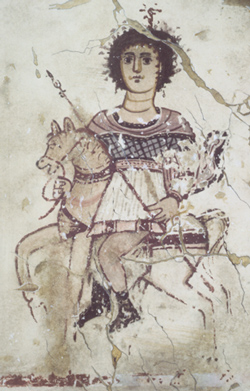
 |
 |
 |
 |
 |
 |
 |
 |
 |
 |
Cloth Goods
 |
|
Wall painting of
the Soldier-God, Heron There was no standard uniform for the Roman army. Instead, soldiers and officers made use of common garment types. This image of the soldier-god Heron represents fine examples of the kind of clothing and equipment that might be worn by a high-ranking military officer: tunic, short cape, belt, trousers, socks, boots, and armor. Note that there are, in addition, a fringed blanket on the horse’s back and other items made of cloth, rope, and leather. |
The texts in this section hint at the surprisingly wide variety of cloth goods available in Roman Egypt, and they give a sense of the actual settings and circumstances in which the textiles were used and valued. Most of the texts are private letters from the early second-century archive of the soldier Claudius Tiberianus, who seems to have functioned as the head of an extended family living in various towns and cities in Egypt. These letters written to Claudius Tiberianus often mention transport of cloth goods within Egypt. Several are especially informative about soldiers’ needs for particular items.